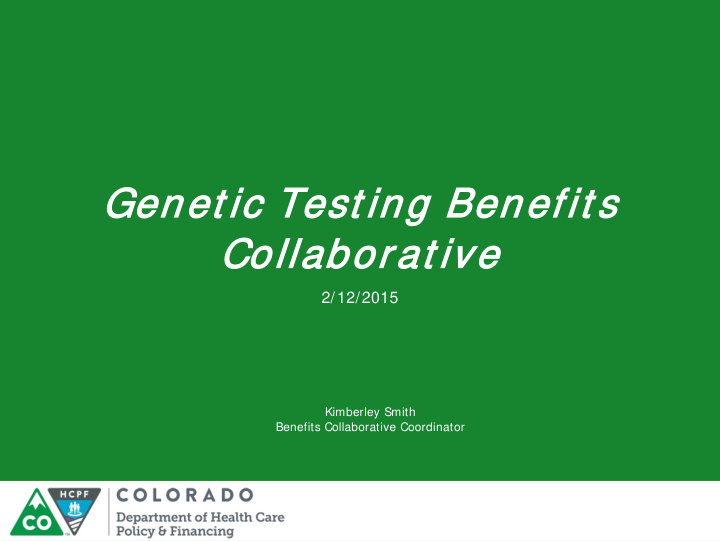



Gen enet et ic Test est ing Ben enef efit s s Collabora rat ive 2/12/2015 Kimberley Smith Benefits Collaborative Coordinator
Our M r Mis ission ion I mproving health care access and outcomes for the people we serve while demonstrating sound stewardship of financial resources
Wha hat i t is t he t he B Bene nefit s t s Collab ollaborat orat iv ive Proc rocess?
• Identifies what services are covered by Colorado Medicaid. • Defines the appropriate amount, scope and duration of a covered service. • States determination of whether a given service is medically necessary. • Describes the service. • Lists who is eligible to provide and receive said service and where.
What ’s My R Role Here Tod oday ay ? How ow Do I o I Part art ic icip ipat at e?
Your Role Participants Are Consultants Your role is to provide suggestions for policy improvement based on: • Evidence based research and data • Peer reviewed literature • Knowledge of the population we serve
Guiding Principles Policy Suggestions Adopted Will : • Be guided by recent clinical research and evidence based best practices, wherever possible. • Be cost effective and establish reasonable limits upon services. • Promote the health and functioning of Medicaid clients.
Guiding Principles What is meant by “recent clinical research” ? • A body of research based on consistent clinical results that speaks to the efficacy of a treatment. • Fields of medicine evolve at different rates. Generally, research is considered “recent” when within the last three years.
Guiding Principles What is meant by “evidence based best practice” ? • Best practices are generally defined by professional organizations, representing practitioners who administer the service(s) in question. • Best practices are typically derived from the type of clinical research already mentioned.
Guiding Principles What is meant by “cost effective” ? • A service must be effective in relation to its cost. Example: the cost of providing Breast and Cervical Cancer Screening to all clients with a family history is offset by the effectiveness of early detection and the money saved through prevention. What “cost effective” does not mean: • Cost effective does not mean cheap or ineffective.
Our Role • To seek out the feedback of the population we serve and those that support them. • To implement suggested improvements that meet the collaborative’s guiding principles. • To foster understanding in the community about how policy is developing, and why.
Ground Rules Participants Are Asked To: • Mind E-manners • Identify Yourself • Speak Up Here & Share The Air • Listen for Understanding • Stay Solution Focused • Stay Scope Focused
Gen enet et ic Test est ing Kimberley Smith Benefits Collaborative Coordinator
What are the CDC Guidelines? CDC Office of Public Health Genomics ranks a list of genomic tests according to their respective levels of evidence and family health history in practice. Tests are grouped into three ranking categories: Green (Tier 1), Yellow (Tier 2) and Red (Tier 3). http://www.cdc.gov/genomics/gtesting
Why has the Department Chosen to use the CDC Guidelines? • Rigorous methodology used by the CDC • Tests were assessed for both statistical and clinical validity, as well as the benefit to the client. • CDC Tier system provides the Department an unbiased test list, which utilizes a peer reviewed process, established in the medical literature. • Allows the Department to provide medically necessary genetic testing, without delaying client care in order to conduct research. • The CDC Tiers are easy to follow guidelines which will expand with the scientific breakthroughs in this field.
Why has the Department Chosen to use the CDC Guidelines? Previously proposed system (algorithm) unworkable Under the old algorithm, ordering providers were required to do more research to determine if a test for a specific client was covered, including: • Determining that the chance of genetic abnormality was >= 10% before requesting the test; and • Determining if the test is US PS TF or EGAPP recommended; and Confusion also existed with regard to how the accompanying ACCE guidelines were evaluated and reported.
Eligible Providers The Department requires that genetic testing and test counseling must be provided by Colorado Medicaid enrolled practitioners who can render the service within the scope of their practice, certifications, and licensure.
Eligible Providers The Department has received requests to mandate genetic counseling and limit genetic counseling to credentialed genetic counselors; we have not done so for several important reasons: • Licensure Some states have instituted licensure for genetic counselors. In those states the term “genetic counselor” refers only to a licensed provider. The Colorado Department of Regulatory Agencies (DORA) has not yet instituted such licensure requirements for genetic counselors, which would make such a provision difficult to enforce.
Eligible Providers (cont.) • Access to Care Per Title XIX of the Social Security Act, services provided to Medicaid clients must meet state wideness criteria. Mandating that counseling be administered by certified genetic counselors creates an access to care issue for many clients who do not, for example, live along the front range.
Genetic Counseling The Department is committed to ensuring that clients receive appropriate counseling and has taken the following actions: • Created a new provider type in MMI S , so that genetic counselors certified through the American Board of Genetic Counselors are now able to enroll with Medicaid and bill for counseling services. • Added a provision in the draft standard that practitioners (such as physicians) who are ordering a genetic test but who are unable to counsel a client regarding genetic testing, must refer the client to a professional who is able to provide counseling services within their scope of practice.
Disc scussi ssion
Than ank Y You ou
Recommend
More recommend